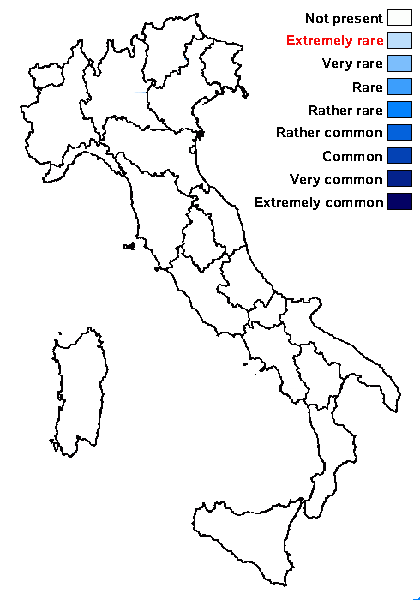Micarea submilliaria (Nyl.) Coppins
Graphis Scripta, 6, 1: 37, 1994. Basionym: Lecidea submilliaria Nyl. - Flora, 52: 410, 1869
Synonyms: Bacidia subleprosula Vězda; Bilimbia submilliaria (Nyl.) Arnold; Lecidea granulans Vain.; Micarea granulans (Vain.) Timdal; Micarea subleprosula (Vězda) Vězda
Distribution:
Description: Thallus crustose, episubstratic, ash-grey or bluish-grey, of scattered to usually coalescing (in the central, thicker parts of thallus), convex to globose, 0.1-0.4 mm wide, fragile, eroding areoles which easily break down into sorediate patches, the soredia 20-50 μm thick. Apothecia not always present, micareoid, more or less globose and constricted at base, sometimes aggregated into tuberculate aggregates, grey-brown, brown-black to black, often with a bluish tinge, 0.2-0.8 mm across, without a distinct proper margin. Proper exciple distinct only in young apothecia, colourless to pale brown in upper part, of radiating, branched and anastomosing hyphae; epithecium scarcely differentiated from the hymenium, olivaceous green to pale reddish brown, K-, N+ red; hymenium colourless, 70-90 μm high; paraphyses numerous, branched and anastomosing, 1-1.5 μm thick, the apical cells up to 1.8 μm wide; hypothecium colourless or pale straw-coloured, 120-300 μm high. Asci 8-spored, clavate to cylindrical-clavate, with an unstained wall and a K/I+ blue outer layer and apical dome, the latter with a non-amyloid, cylindrical axial mass. Ascospores 3-7(-9) septate, hyaline, fusiform, often slightly curved, (35-)40-50(-60) x 5-6.5 μm. Photobiont micareoid, the cells 4-7 μm wide. Spot tests: thallus K-, C+ red, KC+ red, P+ yellow. Chemistry: alectorialic acid plus two accessory substances.
Note: on mosses and plant remains on siliceous rocks in alpine heaths; widespread but rare, perhaps overlooked, being often sterile, with a few records from the Eastern Alps (Austria, Germany); to be looked for in the Italian Alps.
Growth form: Crustose
Substrata: rocks, soil, terricolous mosses, and plant debris
Photobiont: green algae other than Trentepohlia
Reproductive strategy: mainly asexual, by soredia, or soredia-like structures (e.g. blastidia)

Predictive model
Growth form: Crustose
Substrata: rocks, soil, terricolous mosses, and plant debris
Photobiont: green algae other than Trentepohlia
Reproductive strategy: mainly asexual, by soredia, or soredia-like structures (e.g. blastidia)

Predictive model
 Index Fungorum
Index Fungorum
 GBIF
GBIF


